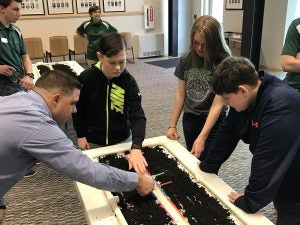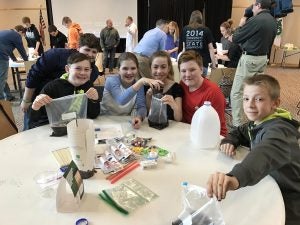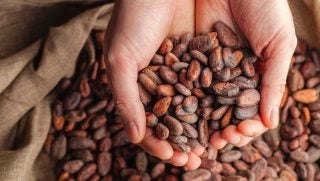What happens when you let 4-H students mix a CSI approach with STEM skills to conquer a real-world challenge in agriculture? You get active participation and a newfound passion for agriculture.
Four years ago, the Ag Innovator Experience just seemed like the next step in Monsanto’s decades-long partnership with the National 4-H council. Since then more than 25,000 4-H students from across the country have had the opportunity to participate in a Fish Farm Challenge, asking participants to engineer a food distribution system that evenly dispenses soy-based fish food pellets to demonstrate the value of aquaculture; a Windmill Challenge, where students were asked to build a water windmill structure that simulates how wind-powered electricity can deliver clean, safe water to crops and farm animals; and a Honey Bee Challenge, that focused on educating youth about pollinators.
“In developing the Ag Innovators Experience Healthy Soils Carbon Soil Investigation (CSI) Challenge, we were looking to create a fun, engaging and interactive program that ties ag education with critical thinking skills and STEM (science, technology, engineering, math) to a real-world challenge within agriculture while helping them hone and develop practical and professional skills while instilling a passion for agriculture,” said Brian Leake, Advocacy and Communications Manager, Monsanto.

With this year’s stewardship focus on soil, Monsanto and the National 4-H Council have partnered with Ohio State University to develop age-appropriate curriculum for middle-school 4-H members to provide a hands-on, interactive experience in learning more about the importance of soil health and its important role within agriculture.
More than 5,000 students across five states have the opportunity to experience the Healthy Soils Carbon Soil Investigation Challenge as part of the 2017 4-H Ag Innovators Experience activity. The initiative began in March and will continue through July at various sites, including traditional 4-H clubs, 4-H camps, school enrichment, and 4-H afterschool settings.
“We’ve selected this topic because of the importance that soil has when it comes to feeding a rapidly growing population – expected to exceed 9 billion by 2050 – and because soil is the place where it really all begins,” Leake said. “The two-part, collaborative, hands-on challenge, developed by The Ohio State University, helps youth to not only discover the composition of soil, but also understand the impact of tilling soil and explore new ways to farm with less disruption to the soil ecosystem.”
Leake said the importance of soil is often overlooked and the fact is that healthy soil not only helps provide a strong foundation for strong, healthy, high-yielding crops, but also has the ability to sequester carbon in the soil, which can help mitigate carbon release into the atmosphere and ultimately can play a role in combating climate change.
So far the feedback to this year’s Healthy Soils Challenge has been phenomenal.

“Students love the hands-on approach of the event and the most popular activities have involved getting their hands a little dirty – literally,” Leake said.
Comparing soil samples to learn more about what makes up ‘healthy’ and ‘unhealthy’ soil as well as building their own 1:64 scale no-till planter (using tiny robot motors and the direction to design the planter to disrupt the least amount of soil when planting) in order to minimize equipment drag and reduce soil compacting, are among the favorites.
Many students have said the initiative has opened their eyes to soil and the fact that many have not given much thought to the topic prior to participating in the Challenge and discussions.
“Participants begin to realize the importance of healthy soils, good and bad soil management practices, and some modern agriculture approaches to preserving soil health, such as no-till planting, use of cover crops, applying the right amount of products at the right time, and application of data science,” Leake said.
If a 4-H chapter would still like to implement the program, 4-H educators and volunteers can access the resources by logging on 4-H.org. A teen facilitator guide and an introductory video serve as tools to understand the Challenge while enhancing the activity.
“Our hope is that students explore the composition and living elements of soil to better understand the importance that soil health plays in growing healthy crops,” Leake said. “By the end of the activity, we hope that youth also begin to understand how properly maintained soil can help reduce agriculture’s carbon footprint.”



